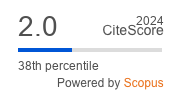Review of the supernumerary renal arteries by dissection method
Keywords:
multiple renal artery, variations, renal dissectionAbstract
Introduction. A thorough knowledge of the variations ofthe renal artery has grown in importance with the increasingnumbers of renal transplants. The literature indicates thatmultiple renal arteries are found in 9-76% cases. The purposeof this study was to establish the incidence and characteristicsin cadavers. Methods. The examinations were performed on39 cadavers dissected in the Department of Anatomy Facultyof Medicine University of Sarajevo. Results. The anatomicalfindings included the presence of multiple renal arteries in18 (46.15) cases. Most often the hilar and lower polar arterieswere found, while the upper polar artery was present in only5.1% cases. Conclusions. In preparation for interventions,such as live renal donation, vascular reconstruction, renovascularhypertension, or radical nephrectomy, preoperativerenal imaging is necessary and operative techniques shouldbe considered with attention to multiple renal arteries. Therecognition of multiple renal arteries is bothReferences
Berardinelli L. Technical problems in living donor transplantation. Transplant Proc. 2005;37(6):2449-50.
Graves FT. The anatomy of the intrarenal arteries in health and disease. Br J Surg. 1956;43:605-16.
Sykes D. The arterial supply of the human kidney with special reference to accessory renal arteries. Br J Surg. 1963;50:368-74.
Ćuš M. Arteriovenosus anastomoses owing to the arterial segments in human kidney. Folia Medica. 1967; 2(2):127-37.
Bergman RA. Renal arteries. Illustrated Encyclopedia of Human Anatomic Variation. Baltimore and Munich: Urban & Schwarzenberg ; 2003.
Andreoni KA, Weeks SM, Gerber DA, Fair JH, Mauro MA, McCoy L, et al. Incidence of donor renal fibromuscular dysplasia: does it justify routine angiography? Transplantation. 2002;15(7):1112-6.
Satyapal KS, Haffejee AA, Singh B, Ramsaroop L, Robbs JV, Kalideen JM. Additional renal arteries: incidence and morphometry. Surg Radiol Anat. 2001;23(1):33-8.
Singh G, Ng YK, Bay BH. Bilateral accessory renal arteries associated with some anomalies of the ovarian arteries: a case study. Clin Anat. 1998;11(6):417-20.
Merklin RJ, Michels NA. The variant renal and suprarenal blood supply with data on the inferior phrenic, ureteral and gonadal arteries: a statistical analysis based on 185 dissections and review of the literature. J Int Coll Surg. 1958;29 (Part 1):41-76.
Du Toit DF, Saaiman JA, Labuschagne BC, Vorster W, Van Beek FJ, Boden BH, et al. EVAR: critical applied aortic morphology relevant to type-II endoleaks following device enhancement in patients with abdominal aortic aneurysms. Cardiovasc J S Afr. 2004;15(4):170-7.
Tan SP, Bux SI, Kumar G, Rayack AH, Chua CB, Lee SH, et al. Evaluation of live renal donors with three-dimensional contrast-enhanced magnetic resonance angiography in comparison to catheter angiography. Transplant Proc. 2004;36(7):1914-6.
Troppmann C, Wiesmann K, McVicar JP, Wolfe BM, Perey RV. Increased transplantation of kidneys with multiple renal arteries in the laparoscopic live donor nephrectomy era: surgical technique and surgical and nonsurgical donor and recipient outcomes. Arch Surg. 2001;136(8):897-907.
Khamanarong K, Prachaney P, Utraravichien A, Tong-Un T, Sripaoraya K. Anatomy of renal arterial supply. Clin Anat. 2004;17(4):334-6.
Glodny B, Cromme S, Wortler K, Winde G. A possible explanation for the frequent concomitance of arterial hypertension and multiple renal arteries. Med Hypotheses. 2001;56(2):129-33.
Anson BJ, Kurth LE. Common variations in the renal blood supply. Surg Gynecol Obstet. 1955;100(2):157-62.
Boijsen E. Angiographic studies of the anatomy of single and multiple renal arteries. Acta Radiol Suppl. 1959;183:1-135.
Spring DB, Salvatiena O Jr, Palubinskas AJ, Amend WJ Jr, Vincenti FG, Feduska NJ. Results and significance of angiography in potential kidney donors. Radiology. 1979;133(1):45-7.
Norman DJ. An unusual renal arterial anomaly: common origin of arteries to the lower poles. Act Radiol. 1970;43:50-5.
Aubert J. Koumare K.Variations of origin of the renal artery: a review covering 403 aortographies. Eur Urol. 1975;1(4):182-8.
Giessing M, Kroencke JT, Taupitz M, Feldmann C, Deger S, Turc I, Budde K, Ebeling V, at al. Gadolinium-enhanced three-dimensional magnetic resonance angiography versus conventional digital subtraction angiography: which modality
is superior in evaluating living kidney donors? Transplantation. 2003;76(6):1000-2.
Ilić A, Đorđević Lj, Blagotić M. Neki naši rezultati anatomskih i rentgenoloških proučavanja prekobrojnih arterija bubrega. Folia anatomica Iugoslavica. 1977;2(6):145-152.
Eitan R, Abu-Rustum NR, Walker JL. Barakat RR. Ligation of an anatomic variant of renal vasculature during laparoscopic periaortic lymph node dissection: a cause of postoperative renal infarction. Gynecol Oncol. 2003;91(2):416-20.






